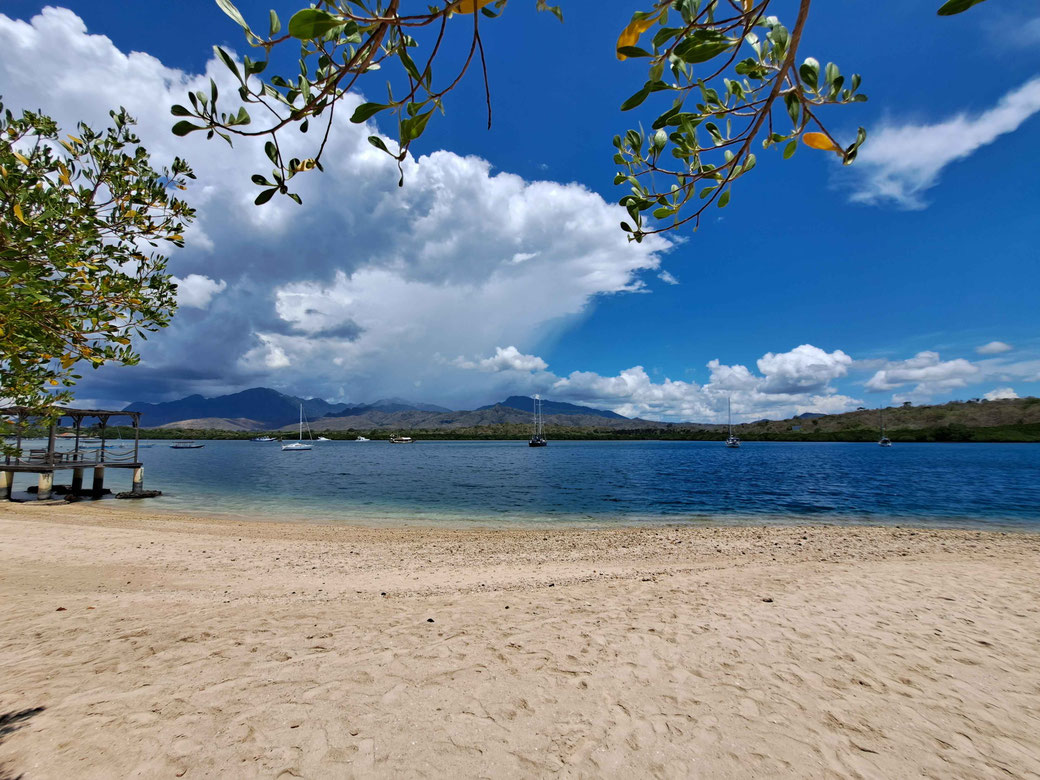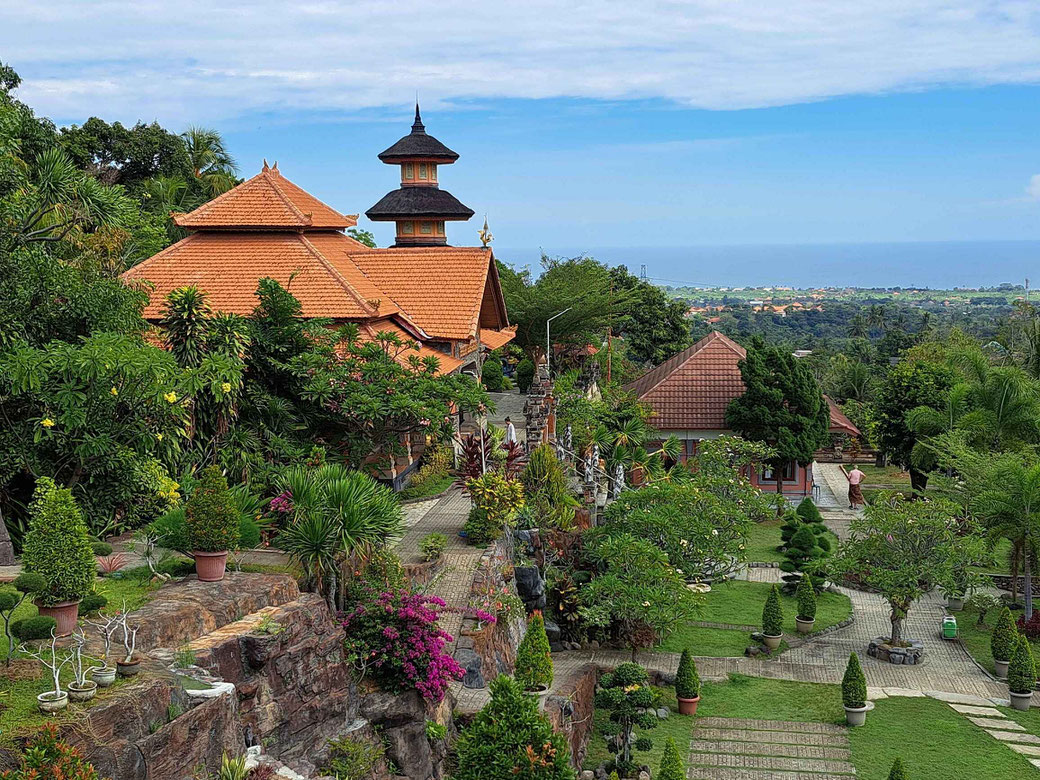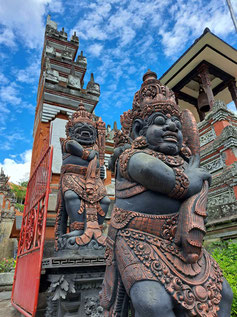bululeng
The regency that covers the northern part of Bali Island is called "Buleleng Regency," also known as "Kabupaten Buleleng" in Indonesian. Buleleng is one of the nine regencies of Bali, Indonesia, and it is located in the northern part of the island. The capital of Buleleng Regency is Singaraja, which was Bali's main port during the Dutch colonial period.
Buleleng is known for its beautiful beaches, historical sites, and natural attractions. Some of the popular tourist destinations in the regency include Lovina Beach, which is famous for dolphin watching, Gitgit Waterfall, Banjar Hot Springs, and Brahma Vihara Arama, the largest Buddhist monastery in Bali.
History
Buleleng Regency has a rich history dating back to ancient times. It was one of the earliest regions in Bali to have contact with outside cultures, including traders and travelers from China and India. The regency's location along the northern coast of Bali made it a vital trading hub and a center for commerce.
During the 19th century, Buleleng was one of the few Balinese kingdoms that managed to resist Dutch colonial rule for an extended period. The Dutch East India Company (VOC) had established control over much of Indonesia, but Buleleng, under the leadership of its ruler, Gusti Ketut Jelantik, put up significant resistance against Dutch expansion. However, the Dutch eventually defeated Buleleng in 1849 and took control of the region.
Under Dutch colonial rule, Buleleng became part of the Dutch East Indies and was administered as part of the larger island of Bali. The colonial era brought significant changes to the region, including the introduction of modern infrastructure and administration systems.
After Indonesia gained independence from the Dutch in 1945, Buleleng became an integral part of the newly formed Republic of Indonesia. Over the years, the regency has experienced development and growth, particularly in the tourism industry, with attractions like Lovina Beach drawing visitors from around the world.
Singaraja
Singaraja is a historical city located in the northern part of Bali, Indonesia. It is the capital of Buleleng Regency and is often referred to as the "City of Lion" due to its historical symbol, a lion statue, that once stood in the city center. Singaraja has a rich history and culture, and it played a significant role during the colonial period and the early years of Indonesian independence.
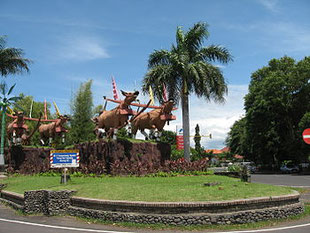
History:
Singaraja's history dates back to the early 17th century when it was a small fishing village. In the 19th century, it grew into a prosperous port town and became the main center of trade and commerce in Bali. The city's strategic location on the northern coast made it a vital port for trade with other Indonesian islands and foreign countries.
During the Dutch colonial era, Singaraja was the capital of Bali and the Lesser Sunda Islands (Nusa Tenggara) under the rule of the Dutch East Indies. It was an important administrative and economic center for the Dutch, and many colonial-style buildings and infrastructure were established during this period.
In 1946, after Indonesia declared independence from Dutch colonial rule, the city became a significant battleground during the Indonesian National Revolution. The local population played a vital role in resisting the Dutch forces, and this period is remembered as a significant part of Singaraja's history.

Culture:
Singaraja has a diverse cultural heritage, shaped by the interactions of different ethnic groups and influences from neighboring islands. The city has been a melting pot of Balinese, Javanese, Chinese, and Arab cultures, among others. This diversity is reflected in the city's architecture, customs, and religious practices.
Traditional Balinese customs and ceremonies are still prevalent in Singaraja, with various temples and religious festivals celebrated throughout the year. The city has a vibrant arts scene, with traditional dance, music, and crafts being an integral part of the local culture.
Due to its historical importance and cultural significance, Singaraja has preserved many of its colonial-era buildings and landmarks, which add to the city's unique charm and appeal.
Today, Singaraja remains an essential city in Northern Bali and serves as a hub for education and administration. It has several schools, universities, and government institutions. While it may not be as prominent a tourist destination as the southern parts of Bali, Singaraja still attracts visitors who are interested in its history, culture, and authentic Balinese experiences.
Buleleng Harbor

The Buleleng Harbor (Pelabuhan Buleleng), is the main seaport in the Buleleng Regency of North Bali.
Buleleng Harbor is also commonly known as Singaraja Harbor due to its proximity to the city of Singaraja.
Buleleng Harbor has historical significance as it was one of the busiest and most important ports in Bali during the Dutch colonial era.
It served as a crucial trading hub for goods coming in and out of Bali, facilitating commerce between the island and other parts of the Dutch East Indies and beyond.
Old warehouses, an ancient jetty and an arched bridge are all that is left of this one time major seaport. Here, a monument has been built in commemoration of Bali´s struggle to defeat the Dutch.
Singa Ambara Raja statue
The Singa Ambara Raja statue, also known as the Lion of Singaraja, is a famous landmark located in Singaraja, the capital of Buleleng Regency in North Bali, Indonesia. The statue holds historical and cultural significance for the local community.
The statue was erected in 1958 and was designed by the Balinese sculptor I Gusti Ketut Kobot (1917-1999). It stands at the heart of the city, in the Bajra Sandhi Park, which is a prominent public park and monument complex dedicated to the struggles and history of the Balinese people.
The Singa Ambara Raja statue depicts a majestic winged lion, symbolizing the bravery and resilience of the Balinese people. It serves as a tribute to the local heroes and warriors who fought for their freedom during the Indonesian National Revolution against Dutch colonial rule.

During the revolution, which lasted from 1945 to 1949, Singaraja played a significant role as one of the main centers of resistance in Bali. The people of Buleleng and Singaraja actively participated in the struggle for independence, and the statue serves as a reminder of their valor and determination.
The name "Singa Ambara Raja" itself has a symbolic meaning:
"Singa" means "lion," representing courage and strength.
"Ambara" means "sky" or "heaven," signifying a divine or spiritual element.
"Raja" means "king," representing leadership and authority.
Together, the name encapsulates the idea of a celestial lion king, symbolizing the heroic and divine qualities of the Balinese people.
The Singa Ambara Raja statue stands as a proud symbol of Singaraja's history and the sacrifices made by its people during the struggle for independence. It has become an iconic landmark in the city and is admired by both locals and visitors alike. The statue's location in Bajra Sandhi Park, surrounded by well-maintained gardens and historical monuments, makes it a significant attraction for those interested in Bali's past and cultural heritage.
Pura Agung Jagatnatha
Pura Agung Jagatnatha is one of Bali´s biggest and newest temples. An outstanding feature is the Padmasana, a shrine that symbolically represents the three parts of the Balinese Universe.
lovina

Lovina is known for its serene and laid-back atmosphere, making it a favorite spot for travelers seeking relaxation and a break from the more crowded and busy areas of Bali.
Beaches: Lovina is famous for its black sand beaches, which are a result of volcanic activity in the region. The beaches provide a unique and picturesque setting for tourists to unwind and enjoy the sunsets.
Dolphin Watching: One of the main attractions in Lovina is the opportunity to go on early morning dolphin-watching boat trips. Travelers can witness pods of dolphins swimming and playing in their natural habitat.
Snorkeling and Diving: The coastal waters around Lovina offer excellent opportunities for snorkeling and diving. Coral reefs and diverse marine life make it a popular destination for underwater enthusiasts.
Hot Springs: There are hot springs located nearby in the village of Banjar. These hot springs are believed to have therapeutic properties

and are a great place to relax and unwind.
Buddhist Monastery: The Brahma Vihara Arama is a beautiful Buddhist monastery in Lovina, attracting visitors with its tranquil gardens and stunning architecture.
Waterfalls: Some stunning waterfalls are accessible from Lovina, including Gitgit Waterfall, which is a popular spot for trekkers and nature enthusiasts.
Local Culture: Lovina offers visitors a chance to experience the authentic Balinese way of life, with local markets, traditional ceremonies, and cultural events.
dolphin tours
Lovina is known for its early morning dolphin watching tours, where visitors can go out to sea in traditional outrigger boats to observe dolphins in their natural habitat. The tours typically start before sunrise when the dolphins are most active, and the sight of these graceful creatures swimming and leaping in the water is a fascinating experience for tourists.
Pulau Menjangan
Menjangan Island, also known as Pulau Menjangan in Indonesian, is a small island located off the northwest coast of Bali. It is part of the West Bali National Park, a protected area known for its diverse marine life, pristine beaches, and lush landscapes. Menjangan Island is a popular destination for snorkelers and divers due to its crystal-clear waters and thriving coral reefs.
Snorkeling and Diving: The island is renowned for its excellent snorkeling and diving opportunities. The coral reefs surrounding Menjangan are considered some of the best in Bali and provide a habitat for a wide variety of marine species, including colorful fish, sea turtles, and other underwater creatures.
Underwater Temple: One of the unique attractions on Menjangan Island is an underwater temple called "Pura Gede Temple." It was deliberately submerged to create an artificial reef and has become a fascinating site for divers.

Pristine Beaches: Menjangan Island boasts beautiful white sandy beaches where visitors can relax and enjoy the tranquil surroundings. The island's name "Menjangan" translates to "Deer" in Indonesian, and it is said that the island got its name due to the presence of deer on the island in the past.
Hiking and Nature Walks: While Menjangan is most famous for its marine activities, it also offers opportunities for nature enthusiasts to explore the island's flora and fauna. The West Bali National Park, which includes Menjangan Island, is home to various wildlife species, including the endangered Bali Starling.
Conservation Efforts: The West Bali National Park, including Menjangan Island, is a protected area aimed at conserving the region's unique biodiversity. Efforts are made to preserve the island's natural beauty and marine ecosystems.
Day Trips and Tours: Menjangan Island is a popular destination for day trips from Bali. Many tour operators offer organized excursions that include snorkeling or diving sessions, transportation, and sometimes a visit to other nearby attractions.
Due to its status as a protected national park, the number of visitors to Menjangan Island is regulated to minimize the impact on the environment. If you plan to visit, it's advisable to check for any entry requirements or guidelines set by the authorities to ensure a sustainable and enjoyable experience.
Divers and visitors to Menjangan Island may catch the boat from the village Labuhan Lalang.
Buddhist temple Brahma vihara-arama
Brahma Vihara-Arama temple, which is also known as the Brahma Arama Vihara or simply Brahma Arama.
History:
The Brahma Vihara-Arama temple is a Buddhist monastery located in the village of Banjar, in the North Bali region of Indonesia. It was founded by Bhante Giri Rakkhita Thero, a Buddhist monk from Sri Lanka, in 1970. Bhante Giri Rakkhita Thero dedicated his life to establishing the temple, and his efforts have made it one of the most significant Buddhist sites on the island.
Culture and Architecture:
The temple follows traditional Buddhist architecture and design. It is nestled in a serene hillside location, surrounded by lush greenery and scenic views, creating an atmosphere of peace and tranquility. The complex combines elements of Balinese and Buddhist architecture, offering a unique blend of the local culture with Buddhist spirituality.
The temple complex consists of several buildings and structures, including meditation rooms, prayer halls, pagodas, and beautifully manicured gardens. There are also statues and depictions of Buddhist deities and important figures, adding to the religious and cultural significance of the place.

Brahma Vihara-Arama's Significance:
As a Buddhist monastery, the Brahma Vihara-Arama temple serves as a place of spiritual practice, meditation, and learning for Buddhist monks and practitioners. It's also open to visitors and tourists who wish to experience the tranquility of the surroundings and learn about Buddhism.
The temple is renowned for promoting the practice of the Brahma Viharas, which are four Buddhist virtues or attitudes known as the "Four Immeasurables." These are:
Metta (Loving-kindness): The cultivation of unconditional love and benevolence towards all beings.
Karuna (Compassion): The practice of cultivating compassion and empathy for the suffering of others.
Mudita (Empathetic Joy): Finding joy in the happiness and success of others.
Upekkha (Equanimity): Maintaining balance and equanimity in all situations, regardless of personal preferences or biases.
The temple's emphasis on these virtues reflects its commitment to spreading positive energy and fostering a sense of harmony among people.
Visiting Brahma Vihara-Arama:
If you plan to visit the Brahma Vihara-Arama temple, it's essential to respect the local customs and traditions. Visitors are usually welcome to explore the grounds, engage in meditation, and learn about Buddhism. Modest attire and behavior appropriate for a sacred site are recommended.
Teluk Terima

This place is located about 75 kilometers west of Singaraja. This place is also known as Jayaprana´s grave.
This site remembers the sad love story between a prince, wishing to marry a country girl. However, the king also wished to marry the girl and so he had to kill the prince. While dreaming of the happenings, the girl killed herself rather than marry the wicked king.
A panoramic view to the North makes this a site well worth visiting
Banyuwedang
Located about 60 kilometers West of Singaraja. Natural hot springs with supposed curative powers near a temple. This place need maintenance.
Pulaki Temple
Pura Pulaki (Pulaki Temple) is a significant Hindu temple. It is situated near the town of Banyupoh, not far from the coastal area. The temple is an essential religious and cultural site for Balinese Hindus and a popular destination for both local and international tourists.

Sacred Monkey Forest: The temple is renowned for its sacred monkey forest, where long-tailed macaques roam freely. These monkeys are considered holy and are an integral part of the temple's spiritual significance.
Coastal Location: Pura Pulaki is uniquely positioned on a rocky outcrop overlooking the Java Sea, providing visitors with beautiful views of the ocean.
Ceremonies and Festivals: The temple plays a significant role in hosting religious ceremonies and festivals for the local Hindu community. These events often draw a large number of devotees and visitors who come to witness the traditional rituals and cultural performances.
Architecture: The temple features traditional Balinese Hindu architectural elements, with intricate carvings and statues representing various Hindu deities and mythological figures.
Dress Code: Like most Hindu temples in Bali, proper attire is required to enter Pura Pulaki. Visitors must wear a sarong (a traditional wraparound skirt) and a sash, which are usually available for rent or loan at the temple entrance.
Tourist Facilities: The temple area is well-maintained and equipped with facilities to accommodate tourists, such as parking areas, food stalls, and souvenir shops.
Banjar Tegah Hot Springs
About 20 kilometers West of Singaraja. These slightly sulphuric hot springs are well worth visiting. Set slightly back in the hills, dragon fountains fume hot water into the tiered bathing pools. A number of souvenir shops and a restaurant cater to tourists. A number of local visitors and schools visit at weekends and holidays.
Banjar Hot Springs, also known as "Air Panas Banjar", is a natural hot spring located in the village of Banjar. It's situated approximately 10 kilometers southwest of the town of Lovina Beach.
The hot springs feature three main pools with different water temperatures, and the water is believed to have therapeutic properties due to its high sulfur content. Many visitors come to enjoy the warm and mineral-rich waters, which are said to provide relief for various skin and joint ailments.
The first pool is the hottest, followed by the second and third pools, which are cooler and have regular freshwater flowing into them. The serene and lush tropical surroundings add to the overall relaxing experience.
The Banjar Hot Springs are open to the public, and visitors can
Temukus War Monument
About 15 kilometers from Singaraja. Built by the Dutch and destroyed by the Balinese during the Independence struggle. It was built by the local government in 1992. The monument offers an extraordinary view of Lovina and the coastline.
Sing Sing Waterfall
Gushing falls in the wet season, the water may not fall as much in the dry season. The falls are well signposted.
Banyuning
Banyuning is a village known for pottery and ceramics.
Beratan
Beratan is famous for its gold and silver works with many unique styles.
Gondol
About 50 kilometers West of Singaraja. You can find here a government run fish breeding project. Turtles, shrimps and prawns are included in the program.
Julah
It is said that this is the oldest village in North Bali.
Sangsit
Sangsit is known for its cultural heritage, traditional architecture, and religious sites, including the famous Pura Dalem and Pura Beji.
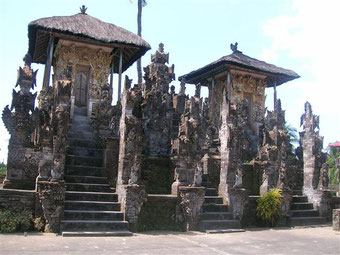
Pura Dalem Sangsit: Pura Dalem is a Hindu temple located in Sangsit village. The temple is dedicated to worshiping Lord Shiva in his manifestation as the god of death and destruction. Like other Pura Dalem temples, it is considered a sacred place for cremation ceremonies and honoring deceased ancestors.
Unique Stone Carvings: One of the main attractions of Pura Dalem in Sangsit is its unique and amusing stone carvings. The temple is renowned for its intricate stone sculptures, which depict various scenes from Hindu epics, folklore, and Balinese daily life. The skilled craftsmanship and attention to detail in these carvings make the temple a fascinating site for visitors interested in art and culture.
Pura Beji: Pura Beji is another type of Hindu temple found in Bali. It is primarily dedicated

to worshiping Dewi Sri, the goddess of rice and fertility.
The temple's name, "Beji," refers to the bathing place or purification ritual that takes place within its premises.
The temple is characterized by its distinctive red-brick architecture, intricate carvings, and a small central tower (meru) with multiple thatched roofs.
It's worth noting that Bali, in general, is known for its rich artistic traditions, including stone and wood carving, dance, music, and painting. Pura Dalem in Sangsit is an excellent representation of this artistic heritage, showcasing the creativity and talent of Balinese artisans.
Gitgit Waterfalls
The Git Git waterfalls are a popular natural attraction located in North Bali, Indonesia. They are situated in the village of Git Git, which is part of the Sukasada District in Buleleng Regency.
The Git Git waterfalls are famous for their picturesque beauty and tranquil surroundings, making them a favorite destination for nature lovers and tourists alike. The waterfalls are surrounded by lush greenery, including tropical plants and dense forests, creating a serene and refreshing atmosphere.
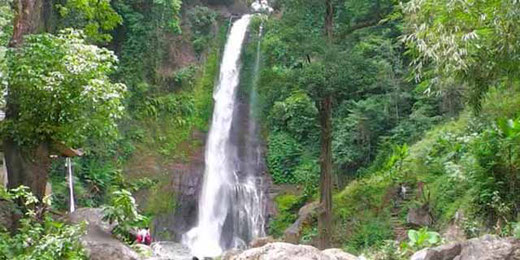
There are actually several waterfalls in the area, but the two main ones are Git Git Twin Waterfalls and Git Git Waterfall. The Git Git Twin Waterfalls are a pair of waterfalls located close to each other, with water cascading down from considerable heights. The Git Git Waterfall is the tallest of them all, with a height of around 35 meters (115 feet). Visitors can witness the magnificent sight of water plunging down into a rocky pool, which is perfect for swimming and cooling off on hot days.
The journey to the Git Git waterfalls involves a short trek through the jungle, and along the way, you can enjoy the beautiful natural surroundings. The paths are well-marked, and there are signs guiding visitors to the waterfalls.
Due to their popularity, the Git Git waterfalls can get busy during peak tourist seasons, so it is advisable to visit early in the day to avoid the crowds and fully appreciate the tranquility of the place.
Kubutambahan & The maduwe karang temple
One of the notable attractions in the village of Kubutambahan is the Maduwe Karang Temple (also known as Pura Maduwe Karang). This temple is renowned for its stunning architecture and intricate stone carvings, which showcase the exquisite craftsmanship of the Balinese people. The temple's design and decoration exemplify the unique blend of Balinese and Javanese architectural styles.
Maduwe Karang Temple is dedicated to worshiping the god of agriculture and prosperity, Lord Vishnu, as well as other deities. The temple holds significant religious importance for the local community, and it is a place of regular ceremonies and festivals. The Maduwe Karang Temple is also renowned for carvings of a very imaginative nature. One of such carvings is the one of a Dutch colonist riding around on a bicycle which tires has been made entirely of petals.
Visitors to Maduwe Karang Temple can marvel at its ornate gateways, called "Candi Bentar," which lead to the inner courtyard. Inside, there are various shrines and pavilions where offerings and prayers take place. The temple is surrounded by lush greenery, adding to its serene ambiance.
When visiting Maduwe Karang Temple or any other religious site in Bali, it is essential to dress modestly and respectfully, covering your legs and shoulders as a sign of cultural sensitivity.
Jagaraga
This is another Northern temple that has amusing carvings. Some of the carvings depict the Dutch colonialists getting drunk, an armed robbery and a wartime dogfight between airplanes.
Air Sanih
Air Sanih is a popular destination in North Bali known for its natural spring-fed pool with cool water. It is also sometimes referred to as "Yeh Sanih" or "Yeh Air Sanih." The name "Air Sanih" itself means "healthy water" in Balinese.
The main attraction of Air Sanih is the large freshwater pool, which is filled by natural springs originating from the nearby hills. The water in the pool is crystal clear and refreshing, making it an ideal place for visitors to take a dip and cool off, especially during hot days.
The pool is surrounded by lush greenery and it borders the beach. It's a popular spot among both locals and tourists who want to enjoy a relaxing day out in nature. The area around the pool has basic amenities like changing rooms and small warungs (local food stalls) where visitors can purchase snacks and drinks.
Apart from swimming and enjoying the natural beauty of the pool, some visitors also believe that the water at Air Sanih has healing properties and is good for health, hence the name "healthy water."
lake tamblingan & lake buyan
Lake Tamblingan and Lake Buyan are twin crater lakes located in the highlands of Bali.
Lake Tamblingan:
Location: Lake Tamblingan is the smaller of the two lakes and is located on the eastern side of the pair.
Size: It covers an area of about 1.45 square kilometers with a maximum depth of around 90 meters.
Scenic Beauty: Lake Tamblingan is known for its natural beauty and tranquility. The surrounding area is rich in lush forests, creating a serene and picturesque environment. It is a popular spot for nature lovers and photographers.
Traditional Canoeing: Local fishermen and guides offer traditional canoeing experiences on the lake, using dugout canoes called "jukung." It's a unique and peaceful way to explore the lake and enjoy the scenery.

Lake Buyan:
Location: Lake Buyan is the larger of the two lakes and is situated to the west of Lake Tamblingan.
Size: It covers an area of about 3.9 square kilometers and is the second-largest lake in Bali.
Altitude: Lake Buyan is located at a higher altitude than Lake Tamblingan, which contributes to cooler temperatures in the surrounding area.
Viewpoints: There are several viewpoints around Lake Buyan that offer stunning panoramic views of the lake and the surrounding hills. One popular viewpoint is located along the main road connecting Bedugul and Singaraja.
Both lakes are part of the Bedugul volcanic area and were formed within calderas of ancient volcanoes. The area around the lakes is known for its fertile soil, making it suitable for agriculture, particularly for growing fruits and vegetables.
Tourists often visit Lake Tamblingan and Lake Buyan as part of a tour of the Bedugul region, which is famous for its scenic landscapes, cool climate, and iconic Ulun Danu Beratan Temple situated on the shores of Lake Beratan nearby. The area is a refreshing retreat from the heat and hustle of the more touristy southern parts of Bali.
Ponjok Batu
The Ponjok Batu Temple (ponjok batu means pile of stone) perches on a rocky cliff next to a beach. A fresh water spring bubbles forth right on the beach.
Sembiran
Probably a megalithic village, the culture, dialect and rituals are quite different from the rest of Bali.
Sawan
The villagers are traditional makers of gamelan gongs and other gamelan instruments. The Batu Bolong temple is quite distinct looking.
Munduk
Munduk is Bali´s ecological village. It is known for its stunning natural beauty, including lush green landscapes, rice terraces, waterfalls, and serene lakes. The village is situated in the mountains, providing visitors with a cooler climate compared to the coastal areas of Bali.
Munduk is a popular destination for travelers seeking a more peaceful and off-the-beaten-path experience. Some of the key attractions in and around Munduk include:
Waterfalls: The area is home to several beautiful waterfalls, such as Munduk Waterfall, Melanting Waterfall, and Gitgit Waterfall. These cascading falls offer picturesque spots for relaxation and photography.

Trekking: The surrounding hills and rice terraces offer excellent opportunities for trekking and hiking. Visitors can explore the scenic landscapes and witness the traditional agricultural practices of the local communities.
Twin Lakes: Nearby Munduk, you'll find the twin lakes of Buyan and Tamblingan. These volcanic lakes are encircled by forests, making them a popular spot for nature lovers and photographers.
Coffee Plantations: The region is known for its coffee plantations, particularly Arabica coffee. Some of these plantations offer tours where visitors can learn about the coffee-making process and even sample freshly brewed coffee.
Ulun Danu Bratan Temple: While not located in Munduk itself, the famous Ulun Danu Bratan Temple is a short drive away. This iconic temple is situated on the shores of Lake Bratan and is one of Bali's most photographed landmarks.
comments
This list is for sure not complete. We welcome your comments and encourage you to share additional touristic, cultural, or historical facts about this regency. Your insights will benefit other readers visiting this page.



